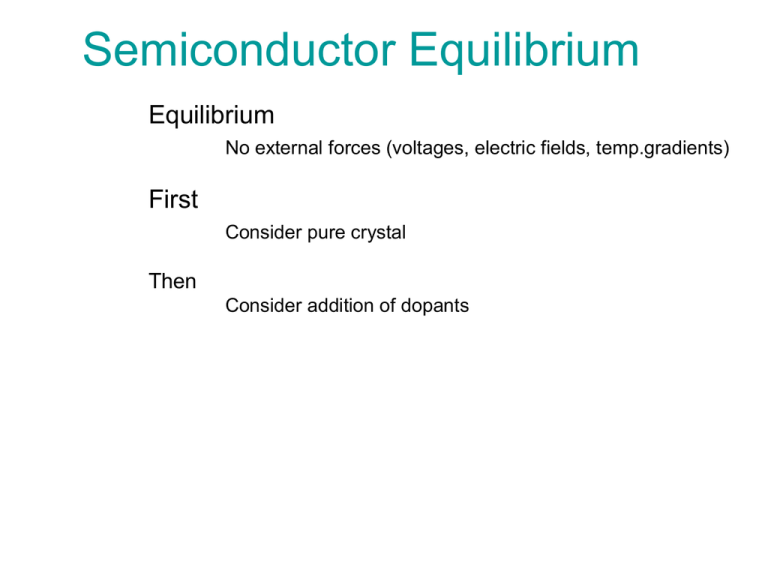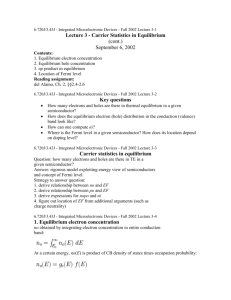Chapter 4
advertisement

Semiconductor Equilibrium Equilibrium No external forces (voltages, electric fields, temp.gradients) First Consider pure crystal Then Consider addition of dopants Semiconductor Equilibrium Charge carriers Electrons in conductance n(E) = gc(E)fF(E) n(E) - prob. dens. of electrons gc(E) - conductance density fF(E) - Fermi-Dirac prob. function Holes in valence p(E) = gV(E)(1 - fF(E)) p(E) - prob. dens. of holes gv(E) - valence density fF(E) - Fermi-Dirac prob. function Semiconductor Equilibrium Charge carriers(cont.) n0 g (E) f c F (E)dE (E C E F ) n 0 N c exp kT 2m*n kT 3 / 2 NC 2 2 h p0 g (E)(1 f (E))dE (E F E v ) p0 N v exp kT v F 2m *p kT 3 / 2 N v 2 2 h Semiconductor Equilibrium Charge carriers(cont.) Example Find the probability that a state in the conduction band is occupied and calculate the electron concentration in silicon at T = 300K. Assume Fermi energy is .25 eV below the conductance band (E c E F ) 5 f F (E) exp exp(0.25/.0259 ) 6.4310 kT (E E F ) 19 5 15 3 n 0 N c (E)exp c (2.8 10 )(6.4310 ) 1.8 10 cm kT Note low probability per state but large number of states implies reasonable concentration of electrons Semiconductor Equilibrium Charge carriers(cont.) For intrinsic semiconductor, concentration of electrons in conductance band is equal to holes in the valence band. Thus, E g (E E v ) ni2 ni pi N c N v exp c N N exp kT c v kT Semiconductor Equilibrium Dopant Atoms (n-type semiconductor) Phosphorous has 5 valence electrons Energy-band diagram Semiconductor Equilibrium Dopant Atoms (p-type semiconductor) Boron has 3 valence electrons Energy-band diagram Semiconductor Equilibrium The Extrinsic Semiconductor n-type p-type Semiconductor Equilibrium The Extrinsic Semiconductor Example Consider doped silicon at 300K. Assume that the Fermi enery is .25 eV below the conduction band and .87 eV above the valence band. Calculate the thermal equilibrium concentration of e’s and holes (E c E F ) 19 15 3 n 0 N c (E)exp (2.8 10 )exp(0.025/0.0259 ) 1.8 10 cm kT (E F E v ) p0 N v (E)exp (1.041019 )exp(0.087/0.0259) 2.7 104 cm3 kT Semiconductor Equilibrium The Extrinsic Semiconductor The n0p0 product E g 2 (E c E F ) (E F EV ) n0 p0 N c N v exp exp N c N v exp ni kT kT kT That is, the product of n0 and p0 is a constant for a given semiconductor at a given temperature. Semiconductor Equilibrium Statistics of donors and acceptors Ratio of electrons in donor state total electrons nd no nd 1 (E c E d ) Nc 1 exp 2N d kT Example Consider phosporous doped silicon at T = 300K and at a concentration of Nd = 1016 cm-3. Find the fraction of electrons in the donor state. nd no nd 1 0.045 2.8 10 exp 0.0259 2 1016 19 1 .41% Semiconductor Equilibrium Compensated semiconductors Formed by adding both donor and acceptor impurities in the same region Energy-band diagram Semiconductor Equilibrium Compensated semiconductors (cont.) With the assumption of charge neutrality, we can derive N d N a 2 (N d N a ) 2 n0 n i 2 2 N a N d 2 (N a N d ) 2 p0 ni 2 2 Example Consider a silicon semiconductor at T = 300K in which Na = 1016 cm-3 and Nd = 3 1015 cm-3. Assume ni = 1.5 1010 cm-3 and find p0 and n0. 1016 31015 2 (1016 31015 ) 10 2 15 3 p0 (1.5 10 ) 7 10 cm 2 2 n i2 n0 3.21104 p0 Semiconductor Equilibrium Position of Fermi energy level As a function of doping levels As a function of temperature for a given doping level










